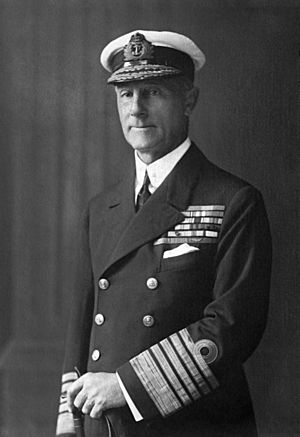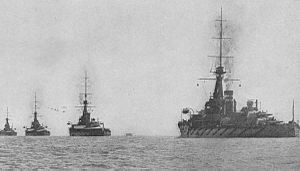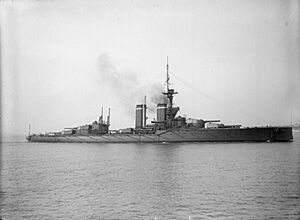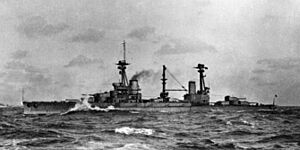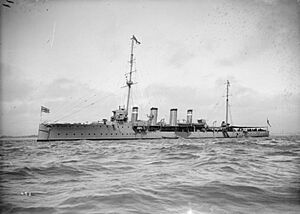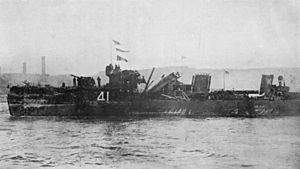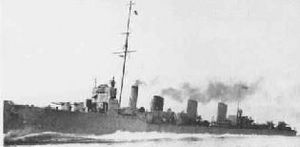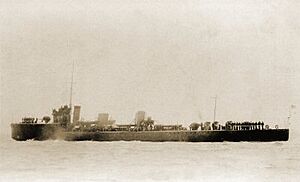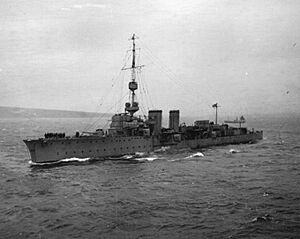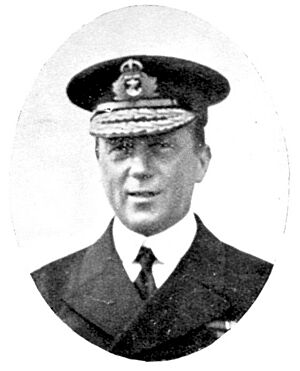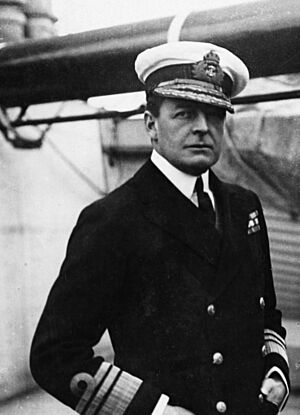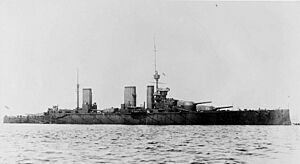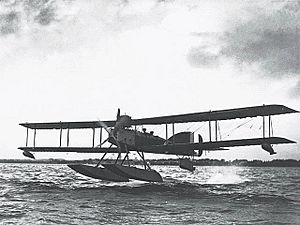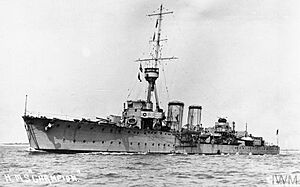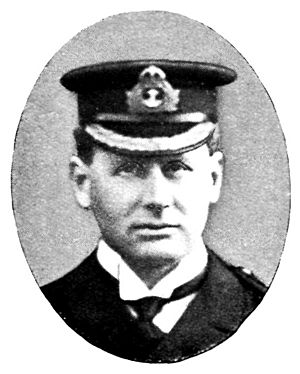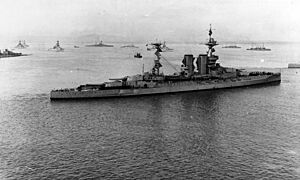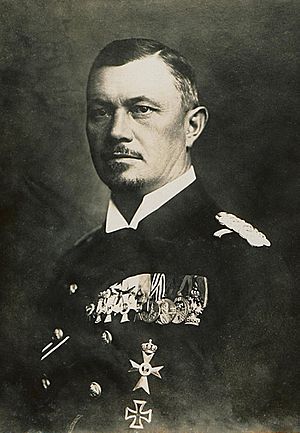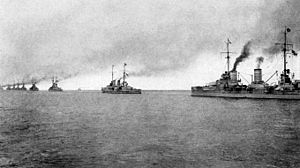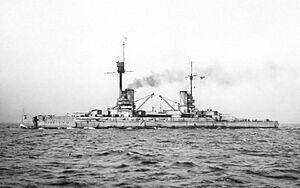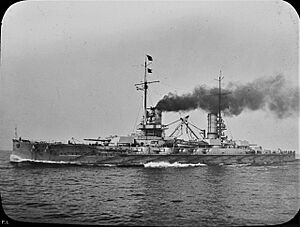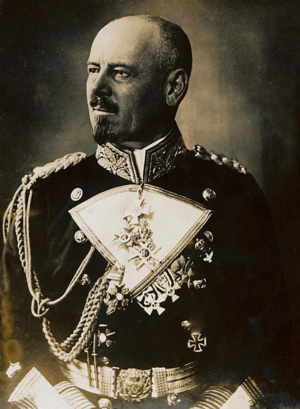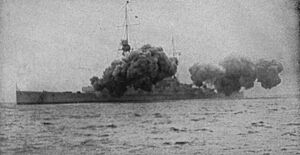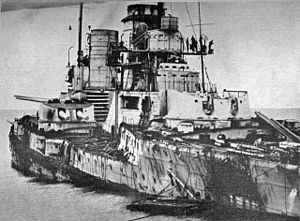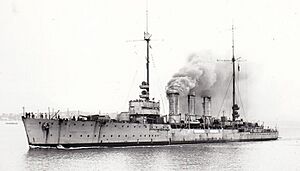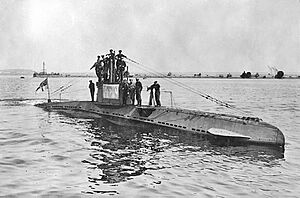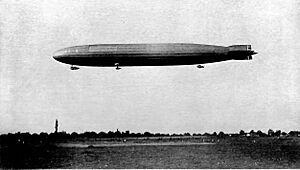Order of battle at Jutland facts for kids
The Battle of Jutland was a huge naval battle fought on May 31 and June 1, 1916, in the North Sea. It was a clash between the Royal Navy of Britain and the Imperial German Navy. This battle involved about 250 warships, making it the largest naval battle in history based on the total weight of the ships involved.
Both sides wanted a big victory to show their people, especially since the land war in Europe was stuck in a stalemate. For example, the Battle of Verdun had been going on for three months when these fleets set sail. Both navies had secret plans to trick the other's powerful battlecruisers into a trap, where they could be destroyed by a larger group of battleships.
In the end, the battle didn't really change the course of World War I. Both Britain and Germany claimed they had won.
Summary of the Battle
Ships That Fought
| Royal Navy (Britain) | Imperial German Navy (Germany) | |
|---|---|---|
|
|
(These were the newest, most powerful battleships) |
(Also powerful, but generally had smaller guns) |
|
(Pre-dreadnoughts) |
(Older, less powerful battleships) |
|
|
|
(Fast ships with big guns, but less armor) |
(Fast ships with big guns, good armor) |
|
|
(Cruisers with some armor) |
|
|
|
26 × light cruisers 79 × destroyers |
11 × light cruisers 61 × torpedo boats (similar to destroyers) |
- The British battleships and battlecruisers had bigger guns overall. This meant they could fire a much heavier total weight of shells in one go compared to the German ships.
- The German "torpedo boats" were very similar in size and role to the British "destroyers."
Ships Lost in Battle
| Dreadnoughts | Pre-dreadnought battleships |
Battlecruisers | Armoured cruisers |
Light cruisers |
Destroyers / Torpedo boats |
|
|---|---|---|---|---|---|---|
| Royal Navy |
HMS Invincible HMS Queen Mary HMS Indefatigable |
HMS Defence HMS Warrior HMS Black Prince |
8 | |||
| Imperial German Navy |
SMS Pommern | SMS Lützow | SMS Frauenlob SMS Rostock SMS Elbing SMS Wiesbaden |
5 |
The Grand Fleet
The Grand Fleet was the main British naval force. It was based in Scotland at Scapa Flow and Invergordon. This huge fleet started sailing on May 28.
- The Commander-in-Chief of the Grand Fleet was Admiral Sir John Rushworth Jellicoe on his flagship, HMS Iron Duke.
Battleships of the Grand Fleet
The Grand Fleet had several groups of battleships, each led by an admiral. These powerful ships formed the main battle line.
- 2nd Battle Squadron: Led by Vice-Admiral Thomas Henry Martyn Jerram. These ships joined Jellicoe's main force on May 31.
- 4th Battle Squadron: Led by Vice-Admiral Sir Frederick Charles Doveton Sturdee.
- 1st Battle Squadron: Led by Admiral Sir Cecil Burney.
Cruisers of the Grand Fleet
Cruisers were faster than battleships and were used for scouting and protecting the main fleet.
- 1st Cruiser Squadron: Led by Rear-Admiral Sir Robert Keith Arbuthnot. His flagship, HMS Defence, was sunk during the battle.
- 2nd Cruiser Squadron: Led by Rear-Admiral Herbert Leopold Heath.
- 4th Light Cruiser Squadron: Led by Commodore Charles Edward Le Mesurier.
- Some light cruisers were also attached to the main fleet to relay signals.
Destroyers of the Grand Fleet
Destroyers were small, fast ships armed with torpedoes, used for attacking larger ships and protecting their own fleet.
- 4th Destroyer Flotilla: Led by Captain Charles John Wintour. His ship, HMS Tipperary, was sunk.
- 11th Destroyer Flotilla: Led by Commodore Hawksley.
- 12th Destroyer Flotilla: Led by Captain Anselan John Buchanan Stirling.
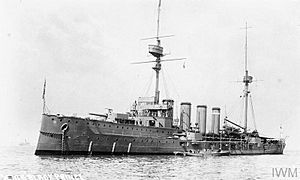
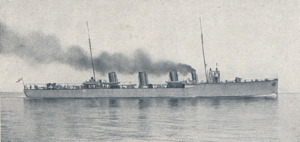
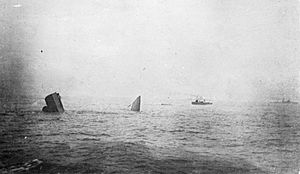
3rd Battle Cruiser Squadron
This squadron was temporarily with the Grand Fleet. It was meant to join the Battle Cruiser Fleet when fighting started.
- Rear-Admiral The Hon. Horace Lambert Alexander Hood led this squadron. His flagship, HMS Invincible, was sunk during the battle.
- It included battlecruisers like HMS Inflexible and HMS Indomitable.
- It also had accompanying light cruisers and destroyers.
Battle Cruiser Fleet
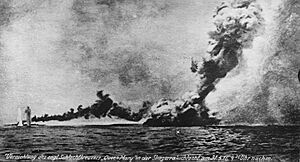
This fast group of ships was part of the Grand Fleet but operated ahead of it. Their job was to scout for the enemy fleet and engage any smaller enemy forces. They sailed from Scotland on May 30.
- Vice-Admiral Sir David Richard Beatty commanded this fleet from his flagship, HMS Lion.
Battlecruisers of the Battle Cruiser Fleet
- HMS Lion: Admiral Beatty's flagship.
- 1st Battlecruiser Squadron: Led by Rear-Admiral Osmond Brock. It included HMS Princess Royal, HMS Queen Mary, and HMS Tiger. HMS Queen Mary was sunk.
- 2nd Battlecruiser Squadron: Led by Rear-Admiral William Pakenham. It included HMS New Zealand and HMS Indefatigable. HMS Indefatigable was sunk.
Light Cruisers and Destroyers
- Several Light Cruiser Squadrons (1st, 2nd, 3rd) were part of this fleet, led by Commodores and Rear-Admirals.
- The 13th Destroyer Flotilla and some attached destroyers from the Harwich Force provided escort and torpedo attacks.
5th Battle Squadron
This was a special group of fast battleships. They were meant to be the front line of the main battle fleet. At Jutland, they operated with the Battle Cruiser Fleet.
- Rear-Admiral Hugh Evan-Thomas commanded this squadron from his flagship, HMS Barham.
- Other battleships included HMS Valiant, HMS Warspite, and HMS Malaya.
- The 1st Destroyer Flotilla escorted this squadron.
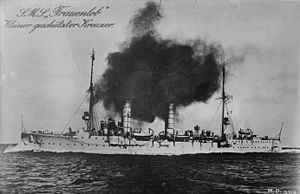
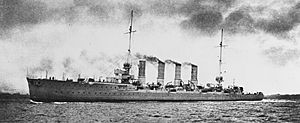
High Seas Fleet (Hochseeflotte)
The High Seas Fleet was the main German surface navy, based at Wilhelmshaven.
- The Commander-in-Chief of the High Seas Fleet was Vice-Admiral Reinhard Scheer on his flagship, SMS Friedrich der Grosse.
Battleships of the High Seas Fleet
- 3rd Battle Squadron: Led by Rear-Admiral Paul Behncke. This squadron included powerful battleships like SMS König, SMS Grosser Kurfürst, and SMS Kaiser.
- 1st Battle Squadron: Led by Vice-Admiral Ehrhard Schmidt. It included battleships like SMS Ostfriesland, SMS Thüringen, and SMS Nassau.
- 2nd Battle Squadron: Led by Rear-Admiral Franz Mauve. This squadron consisted of older battleships, including SMS Deutschland and SMS Pommern. SMS Pommern was sunk.
Light Cruisers and Torpedo Boats
- 4th Scouting Group: This group of light cruisers was led by Commodore Ludwig von Reuter. It included ships like SMS Stettin, SMS München, and SMS Frauenlob. SMS Frauenlob was sunk.
- Several Torpedo-Boat Flotillas (1st, 3rd, 5th, 7th) were also part of the fleet, providing fast attacks and scouting. German torpedo boats were similar to British destroyers.
Scouting Force
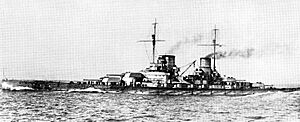
This force was responsible for scouting ahead of the main German fleet.
- The Commander of the Scouting Forces was Vice-Admiral Franz Hipper.
Battlecruisers of the Scouting Force
- 1st Scouting Group: Led by Vice-Admiral Hipper. This group included the powerful battlecruisers SMS Lützow (which was scuttled), SMS Derfflinger, SMS Seydlitz, SMS Moltke, and SMS Von der Tann.
Light Cruisers and Torpedo Boats
- 2nd Scouting Group: This group of light cruisers was led by Rear-Admiral Friedrich Boedicker. It included ships like SMS Frankfurt, SMS Elbing (scuttled), and SMS Wiesbaden (sunk).
- Several Torpedo-Boat Flotillas (2nd, 6th, 9th) were also part of this force.
Submarines and Airships
German submarines (U-boats) were sent to attack the British Grand Fleet in the North Sea during the battle. Airships, known as Zeppelins, were also used for scouting, though bad weather made it hard for them to see much.
- The Leader of Submarines was Captain Hermann Bauer.
- Zeppelins were commanded by Captain Peter Strasser. They flew from bases in Germany.
Images for kids


